Amazon Audible Gift Memberships

Shop Amazon - Create an Amazon Baby Registry
Illustrations from the:
Biblia de San Isidoro de Leon,
Biblioteca, Colegiata S. Isidoro, Leon, 960
Battle of Mount Gilboa

Death of King Saul and his sons. Folio 131v. Photo: O. K. Werkmeister.
Source: p.122 The Art of Medieval Spain AD 500-1200, Metropolitan Museum of Art, New York
El Archivo Capitular de la Colegiata de San Isidoro cuenta entre sus tesoros con una Biblia visigótico-mozárabe realizada por Florencio y Sancho en el año 960. Cuenta con 517 folios y ricas ilustraciones.
The Chapter Archive of San Isidoro Collegiate counts among its treasures a Visigothic-Mozarabic Bible by Florentius and Sanctius in 960. It has 517 pages and rich illustrations.
Source: pp.107-108 The Art of Medieval Spain AD 500-1200, Metropolitan Museum of Art, New York
108
BIBLE
Monastery of Valeranica (Castile), 960
Tempera on parchment
19 x 13⅝ in. (48.5 x 34.5 cm)
Real Colegiata de San Isidoro, León (Cod. 2)
This large, complete Bible is written in two columns in Visigothic minuscule, the Hispanic form of script that was employed on the peninsula between the seventh and the twelfth century.
It opens with a page devoted to Christ with the four evangelist symbols and ten pages of tables tracing in a series of linked medallions the ancestors of Christ, beginning with Adam and Eve;
this is a series unique to the Spanish tradition and present in the Beatus Commentaries as a feature borrowed from Bible illustration.
The illumination of the New Testament consists of seventeen canon tables and small figures of Saint Paul beside the beginning of his Epistles.
In contrast, the Old Testament is extraordinarily rich in illustrations.
Although Genesis has only two pictures - the popular subjects Adam and Eve and the Offering of Isaac -
the Old Testament books that follow display more than eighty subjects in narrative illustrations inserted in the columns of text immediately after the passages that supply their themes.
This system of illustration is one associated with the earliest stages of Christian illumination; it soon gave way to a preference for framed miniatures less tightly linked to the texts that they illustrated.
The column-picture format and parallels between the pictorial organization and compositional formulas associated with early Bible illustration outside of Spain are signs that this Bible represents an ancient tradition of illumination.
Another such sign is the presence of numerous glosses in the margins of the Old Testament giving the Old Latin versions of the Vulgate text, which became standard about 400.
It is probable, then, that the León Bible of 960 was copied from a Spanish Bible from the Visigothic period or earlier,
which itself must have been based upon illustrated books from important Christian centers outside the peninsula.
This manuscript is, therefore, a valuable witness to the early stages of the history of Christian illumination.
From the colophons and a magnificent picture of Sanctius beneath a grand Omega saluting with a raised cup his master, Florentius (fol. 514),
it is clear that this manuscript was copied by Sanctius at the Castilian scriptorium of Valeranica, south of Burgos.
Florentius had been responsible for the Moralia in Job of 945 (cat. 84) and also for a Bible of 943, now lost, that probably served as the model for the Bible of 960 and for the Bible completed in 1162 for San Isidoro in León (cat. 150).
Beyond producing its model, it is not clear what role, if any, Florentius had in the Bible of 960.
Figures in this Bible resemble those in other Spanish manuscripts of the tenth century in that they do not display any sense of plasticity and are enveloped in complex drapery folds patterned in a mosaic of different colors.
John W Williams, Professor of Fine Arts, University of Pittsburgh, Pennsylvania, and Special Consultant to The Metropolitan Museum of Art
Previous Next
Back to the Biblia de San Isidoro de Leon


